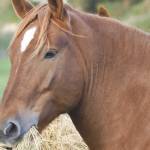Equine Obesity: Researchers Investigate Molecular Biology

Obesity isn’t just a problem in humans, cats, and dogs. It is also a widespread issue affecting horses and ponies in industrialized nations, and is sometimes considered a welfare issue.
“The deleterious impact of obesity on horses is well-documented. Obese horses and ponies are at risk for developing health issues associated with regulation of insulin, a hormone involved in controlling blood sugar levels, including painful and life-threatening laminitis,” says equine nutritionist Kathleen Crandell, Ph.D., from Kentucky Equine Research in Versailles, Ky.
One group of researchers* recently looked at equine obesity from a novel point of view using molecular biology. Skeletal muscle accounts for approximately 40% of a horse’s body weight, plays a key role in a horse’s energy balance, and communicates with other tissues, including fat (adipose) tissue using biological messengers called myokines. The researchers suggested that measuring myokines might yield important information that could help determine how obesity, insulin dysregulation, and laminitis are linked.
Myostatin is a specific myokine that circulates through the body in an inactive form. Unknown stimuli activates myostatin and binds it to receptors.
Studies in mice have shown that myostatin is a negative inhibitor of skeletal muscle mass, meaning that mice without myostatin were hypermuscular and resistant to gains in body fat when fed high-fat diets.
In this recently published study, the authors measured both the genetic material (mRNA) responsible for manufacturing the myostatin protein, its receptor ActRIIB, and the protein levels of myostatin and ActRIIB in fat tissue, in circulation, and in muscle in both lean and obese horses and ponies. Some of the key findings were that the mRNA for ActRIIB was decreased in skeletal muscle in obese animals, mRNA for myostatin was increased in crest fat of obese animals, and circulating levels of myostatin were higher in obese horses and ponies.
Results of this preliminary study support the hypothesis that the so-called “myostatin system” may play a role in equine obesity. According to the authors, “Further work is needed … in horses and ponies to explore the previous speculation from human studies that circulating myostatin levels and/or associated factors might act as biological marker(s) for metabolic conditions including obesity.”
*Morrison, P.K., C. Bing, P.A. Harris, et al. 2014. Preliminary investigation into a potential role for myostatin and its receptor (ActrIIB) in lean and obese horses and ponies. PLoS One 9(11):e112621.








